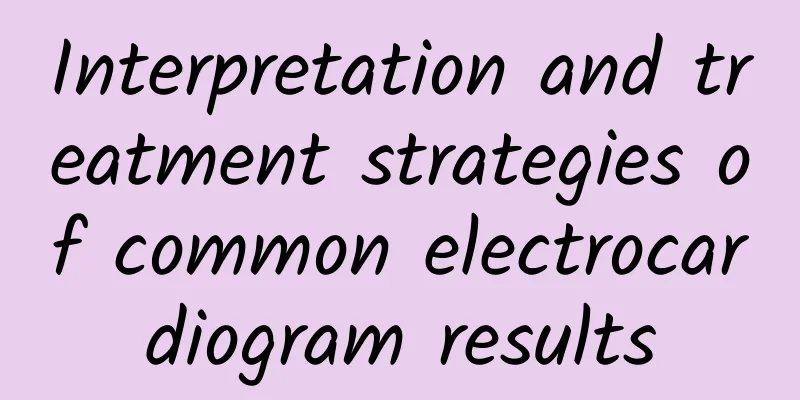Interpretation and treatment strategies of common electrocardiogram results

|
Electrocardiogram (ECG) is a commonly used clinical medical examination used to record and analyze the electrical activity of the heart. By detecting the electrical changes produced by the heart in each cardiac cycle, it can provide information about heart rhythm, myocardial disease, heart valve disease, abnormal heart position, electrolyte imbalance, and other heart diseases. However, sometimes there may be some abnormalities in the results of ECG, which may indicate a problem with the heart or may simply be a physiological change. The following is an interpretation of several common ECG results in clinical practice. 1. Interpretation of common electrocardiogram results 1. Sinus arrhythmia Sinus arrhythmia is the most common type of electrocardiogram. It refers to an irregular heartbeat caused by the irregular discharge of electrical impulses by the sinoatrial node. Sinus arrhythmia itself is not a disease. This condition usually occurs in infants, young people and the elderly. The common symptom is an uneven heartbeat. This irregularity can be divided into pathological and physiological types. The physiological one is generally related to changes in vagal nerve tension during breathing, while the pathological one is generally caused by patients suffering from heart disease, which is more common in coronary heart disease, increased intracranial pressure, cerebrovascular accidents, etc., and there are some potential risks of heart accidents. Generally speaking, patients with sinus arrhythmia who do not have other symptoms do not need treatment and only need to be observed and followed up. 2. Sinus tachycardia The normal adult heart beats between 60 and 100 times per minute. When the heart rate exceeds 100 beats per minute, it is sinus tachycardia. Tachycardia may be caused by a variety of reasons, including emotional tension, use of drugs (such as atropine), congenital heart disease, etc. In most cases, if it is not caused by other diseases, simple tachycardia itself is not a disease and can be controlled by adjusting lifestyle and avoiding stimulation. However, it should be noted that if unexplained sinus tachycardia occurs, it is likely caused by heart disease, fever, anemia, pain, hyperthyroidism and certain drugs. 3. Sinus bradycardia Sinus bradycardia refers to a sinus rhythm of less than 60 beats per minute. In some cases, such as athletes, heavy manual laborers, the elderly and deep sleep, a slower heart rate may be normal. However, if the heart rate is less than 40 beats per minute and related symptoms occur, such as dizziness, fatigue, palpitations, etc., you need to seek medical attention in time. 4. Conduction block Conduction block refers to the phenomenon that the electrical activity of the heart is hindered during the conduction process. On the electrocardiogram, conduction block may be manifested as an abnormal relationship between the P wave and the QRS complex. For example, atrioventricular block is manifested as the QRS complex falling off after the P wave or the PR interval being prolonged; bundle branch block is manifested as the QRS complex being widened and abnormal in shape. Conduction block may be caused by lesions in the cardiac conduction system, or may be related to certain drugs, electrolyte disorders and other factors. 5. QT interval prolongation The QT interval is the time interval from the start of the QRS complex to the end of the T wave on the electrocardiogram, representing the total time for ventricular depolarization and repolarization. A prolonged QT interval may increase the risk of ventricular arrhythmias, such as torsades de pointes. A prolonged QT interval may also be related to certain drugs, electrolyte abnormalities, genetic diseases and other factors. 6. Myocardial hypertrophy Myocardial hypertrophy refers to the phenomenon that myocardial cell proliferation and hypertrophy lead to thickening of the cardiac muscle layer. On the electrocardiogram, myocardial hypertrophy is usually manifested as an increase in the voltage of the QRS complex. For example, left ventricular hypertrophy may show Rv5>2.5mV or Rv5+Sv1>4.0mV (male) or>3.5mV (female). Electrocardiogram examinations show that there are certain false negatives and false positives for myocardial hypertrophy. Myocardial hypertrophy may be a manifestation of diseases such as hypertensive cardiomyopathy and congenital heart disease, and further examination and treatment are required with the help of echocardiography, X-ray, etc. 2. Treatment strategies for abnormal electrocardiogram results For abnormal ECG examination, the treatment strategy should be determined according to the specific cause. The treatment methods include: (1) For abnormal ECG caused by physiological reasons, no special treatment is usually required, and the cause can be eliminated. (2) Patients with myocardial ischemia and coronary atherosclerotic heart disease can take isosorbide mononitrate, isosorbide dinitrate, aspirin, clopidogrel and other drugs for treatment under the guidance of a doctor. If the symptoms are severe, percutaneous coronary intervention (PCI), coronary artery bypass grafting (CGBG) and other surgeries may be required for treatment. (3) Patients with arrhythmia can take antiarrhythmic drugs for treatment under the guidance of a doctor. If the symptoms are severe, catheter ablation can also be performed for surgical treatment. (4) For patients with myocarditis, creatine phosphate, coenzyme Q and other drugs can be taken for treatment under the guidance of a doctor. If the symptoms are severe, extracorporeal membrane oxygenation (ECMO), temporary pacemaker implantation, and heart transplantation can be used for treatment. 3. Precautions for abnormal electrocardiogram results When an abnormal ECG occurs, the patient should pay attention to the following points: (1) Rest and exercise. Pay attention to rest and avoid strenuous exercise. (2) Diet adjustment. Eat a low-salt, low-fat diet, control blood pressure, blood sugar, and blood lipids, eat a light diet, and eat more fresh fruits and vegetables. (3) Regular check-ups. Regularly review the ECG and conduct other heart-related examinations, such as echocardiography and coronary artery CT, so as to detect changes in the condition in a timely manner. (4) Take medication as prescribed by the doctor. Take medication as prescribed by the doctor and do not stop taking the medication or change the dosage on your own. In general, abnormal ECG results do not necessarily mean that you have heart disease. In some cases, they may be harmless physiological reactions or the influence of certain lifestyle habits. However, if you have any uncomfortable symptoms or other risk factors for heart disease, please be sure to see a doctor in time and follow the doctor's professional advice for further examination and treatment. Author: Liu Ping , Guangdong Provincial Maternal and Child Health Hospital |
Recommend
Do babies have better hearing than adults? What to eat during pregnancy to help your baby's hearing development
When a baby is born, it can neither hear nor see ...
Can I eat plums after a cesarean section?
Caesarean section is very harmful to girls' b...
Leucorrhea is yellow, thin and has no odor
Yellow leucorrhea is a common physical condition ...
What causes dry eyes? Lack of sleep and eye fatigue are harmful to eye health
Dry eye syndrome refers to insufficient or uneven...
Why does arrhythmia occur? You need to know this
Everyone must be familiar with electrocardiograms...
What are the symptoms of ovarian luteal insufficiency?
If the ovarian corpus luteum function is incomple...
What should be in a medical emergency kit? Where should the car emergency kit be placed?
It is best for every family to prepare such an em...
Diagram of cervical canal disappearance
After ten months of pregnancy, mothers always ima...
The reason why amniotic fluid cannot be replenished
As the pregnancy time gradually increases, the am...
HootSuite: Snapchat Advertising Statistics for 2022
Snapchat's daily active users (DAU) continue ...
How to treat seasonal allergic conjunctivitis
This is the 4489th article of Da Yi Xiao Hu Conju...
What foods will definitely cause miscarriage?
We all know that if a woman's fertilized egg ...
Which is more accurate, cervical DNA or TCT
With the progress of society, our daily lives are...
What's the matter with a small fleshy lump on the nipple? Experts tell you why
If you find a small lump on your nipple, you usua...
What foot bath is good for dysmenorrhea?
Women will experience irritability during menstru...









